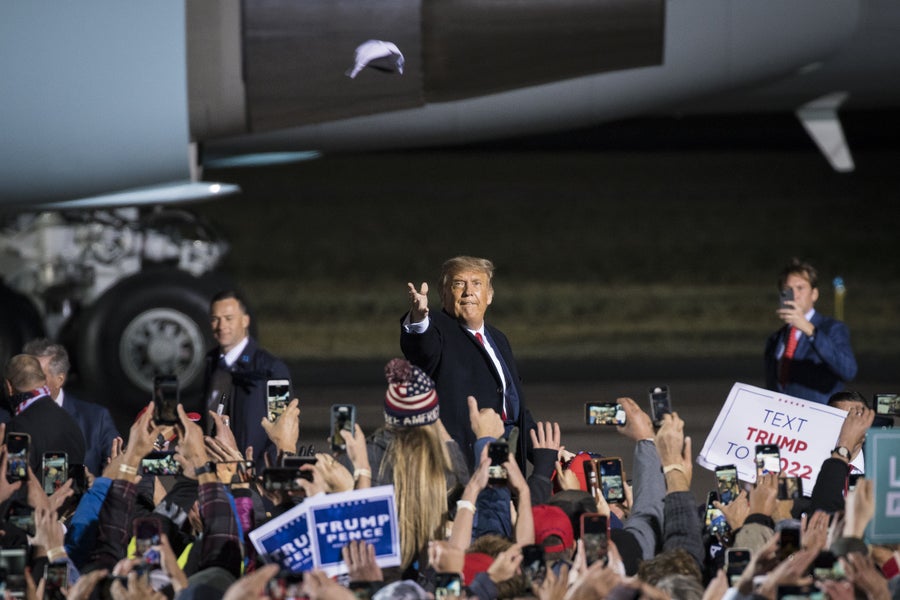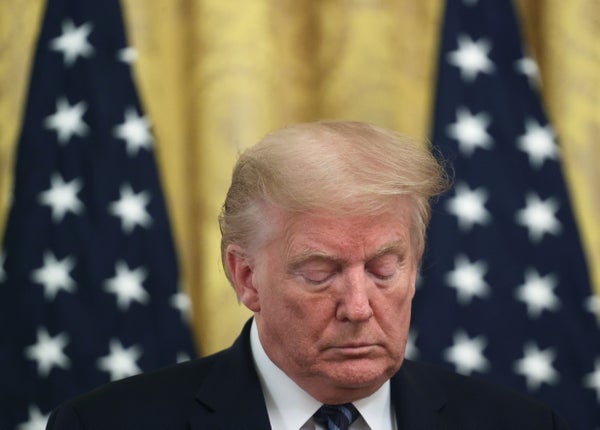President Donald Trump and First Lady Melania Trump have both tested positive for SARS-CoV-2—the virus that causes COVID-19—and are isolating themselves, the president announced in a tweet early Friday morning. The news came in the midst of a pandemic that has killed more than 207,000 people in the U.S., and just weeks before the presidential election.
“This evening I received confirmation that both President Trump and First Lady Melania Trump have tested positive for the SARS-CoV-2 virus,” wrote the president’s doctor Sean Conley in a recent statement. “The President and First Lady are both well at this time, and they plan to remain at home within the White House during their convalescence.”

President Trump tosses a cap at attendees as he arrives at a “Make America Great Again” rally in Duluth, Minn., on September 30, 2020. Credit: Ben Brewer Getty Images
On supporting science journalism
If you're enjoying this article, consider supporting our award-winning journalism by subscribing. By purchasing a subscription you are helping to ensure the future of impactful stories about the discoveries and ideas shaping our world today.
News had emerged on Thursday evening that Hope Hicks, a senior adviser to the president, had tested positive for COVID. Earlier this week she traveled with Trump to a campaign event and to his debate with Joe Biden. On Friday Biden announced on Twitter that he had tested negative, although that does not rule out infection (the virus has a five-day incubation period on average).
“I think, unfortunately, the president would certainly be at higher risk for developing more serious symptoms and will need to be observed closely,” says Tom Inglesby, director of the Center for Health Security at the Johns Hopkins Bloomberg School of Public Health and an expert on pandemic preparedness. “We know this disease affects people in his age group much more seriously than younger adults. People who have underlying conditions like being overweight or having chronic artery disease need to be watched carefully.”
The news underscores the fact that SARS-CoV-2 is a serious virus and that the people who have not previously been infected are still at risk, Inglesby says. He advises people to continue to follow protections such as wearing a mask, avoiding large gatherings, physically distancing from others and washing their hands. The U.S. Centers for Disease Control and Prevention’s guidance states that individuals with COVID-19 may not show symptoms until two to 14 days after exposure. So anyone who has recently had close contact with the president—defined being within six feet of him for more than 15 minutes—may need to be tested and to quarantine themselves for two weeks, Inglesby adds.
“Every country has found that older age—particularly above age 50—substantially increases risk of severe disease and death [from COVID-19]. And it increases with each decade, so individuals greater than 70 years are high risk,” says Chandy John, an infectious disease expert and a professor of pediatrics at the Indiana University School of Medicine. He points out that most data on severe disease come from people who are symptomatic and do not have the same access to frequent testing and medical care that the president does, so it is difficult to extrapolate general data to Trump’s risk. “But there is no question that the president is at higher risk for severe disease than the general population,” John says.
It is unclear whether the 74-year-old Trump or the first lady have experienced severe symptoms. Many people infected with the virus are asymptomatic. But some of the most severe cases have occurred in people older than 65 and in those who are obese. Men are also at higher risk of severe infection than women. The president is exhibiting mild, coldlike symptoms, and some at the White House recently noticed that his voice “sounded raspy,” according to the New York Times, but it was not certain how unusual that might be.
Trump has consistently downplayed the severity of COVID-19, calling it no worse than the flu and dismissing the use of face masks that experts say are critical to controlling the spread of SARS-CoV-2. He has repeatedly touted unproved treatments, including hydroxychloroquine, and has even suggested dangerous ideas, such as injecting bleach into the body.
The president will continue to perform his duties from his quarantine in the White House, his doctor wrote. According to the New York Times, Vice President Mike Pence and Secretary of State Mike Pompeo have so far tested negative.
“I really hope that this makes clear that COVID-19 is real and that anyone can get it,” John says of the Trump’s test results. “It seems silly to have to say that, but there are many people who still insist that the whole thing is a hoax. And I hope that this terrible event makes it clear to them that it is not.”
Editor’s Note (10/2/20): This article was updated after posting to include comments from Tom Inglesby and Chandy John and to include information about Joe Biden testing negative for COVID-19.
